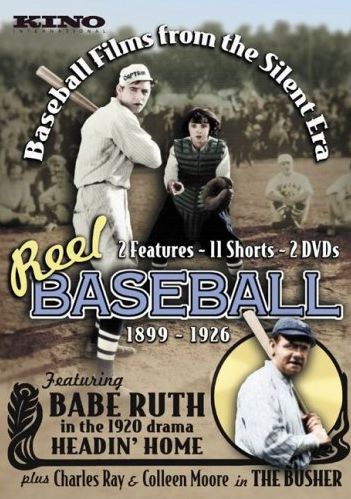
Unless you're one yourself it's probably hard to
imagine how wondrous and magical it is for a baseball fan to watch Headin' Home — one of the films on Kino's new silent-era baseball
set.
The film features Babe Ruth looking unbelievably young
and unusually lanky. The year was 1920 and the Bambino had just been
traded to the Yankees — a year later he would have the most incredible
season any baseball player has ever had and probably ever will have.
(He hit 59 home runs that year — a recent book estimates that under
modern rules and field dimensions the total would have probably been
101, all with the old “dead ball”.)
Ruth looks remarkably composed in front of the camera,
even in the scenes that call for acting — his minimalist style has
aged very well. But what's really stunning is just watching him move
— you see a physical grace and ease, an elegant self-possession, that
doesn't always come across in documentary footage of his on-the-field
play.
Roger Angell has suggested that a core appeal of
baseball in the urban America of the early 20th-Century was its aura of
the pastoral — its wide greensward, like a big enclosed meadow, and
its easy rhythms reminding transplanted urban dwellers of their rural
roots. Headin' Home confirms this insight in a way. It's conceit is
to construct a fictional biography of Ruth as the product of a small
town and small-town values. This was a far cry from the Babe's actual
childhood on some of the meaner streets of Baltimore and in an
orphanage, but it represents how America wanted to view its baseball
heroes.
It must have been strange for Ruth to enact the
fantasy youth conjured up for him by the filmmakers — choppin' down
trees, carvin' his own bats, eatin' mom's apple pie and goin' to the
church social — but he looks utterly nonplused by the whole exercise.
(Ruth
had a delightful and quintessentially American matter-of-fact attitude
to everything. When asked how he felt about making more money than
Herbert Hoover, the President of the United States, Ruth said, “I had a
better year than Hoover.”)
The film appears to have been shot somewhere in
Upstate New York, and it offers delightful images of small-town America
in 1920, including a wonderful recreation of a local ballgame between
rival small towns.
The film also incorporates footage of Ruth in action
in an actual big-league game — part of a framing device in which an
old fellow attending the game reminisces about the Babe's youth “back
home” with genial if uninspired cracker-barrel wit.
But it's the physical presence of Ruth himself that
enchants, whatever he happens to be doing — it's like seeing
documentary footage of Achilles engaged in some amateur theatricals or
demonstrating his prowess with a spear . . . documentary footage of a
mythological being.
